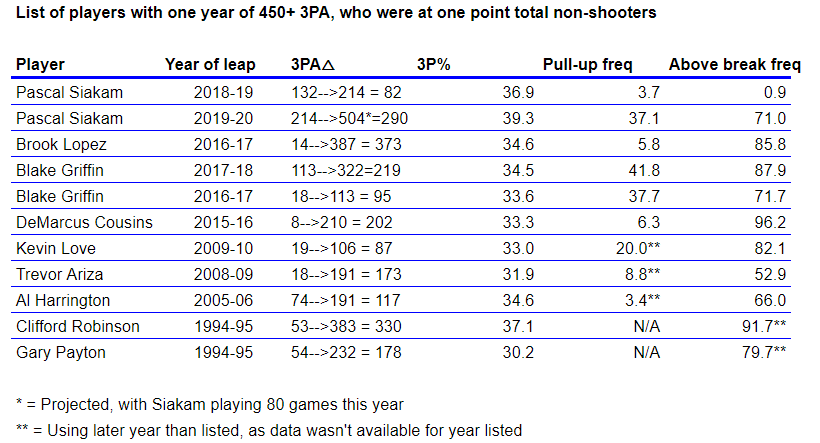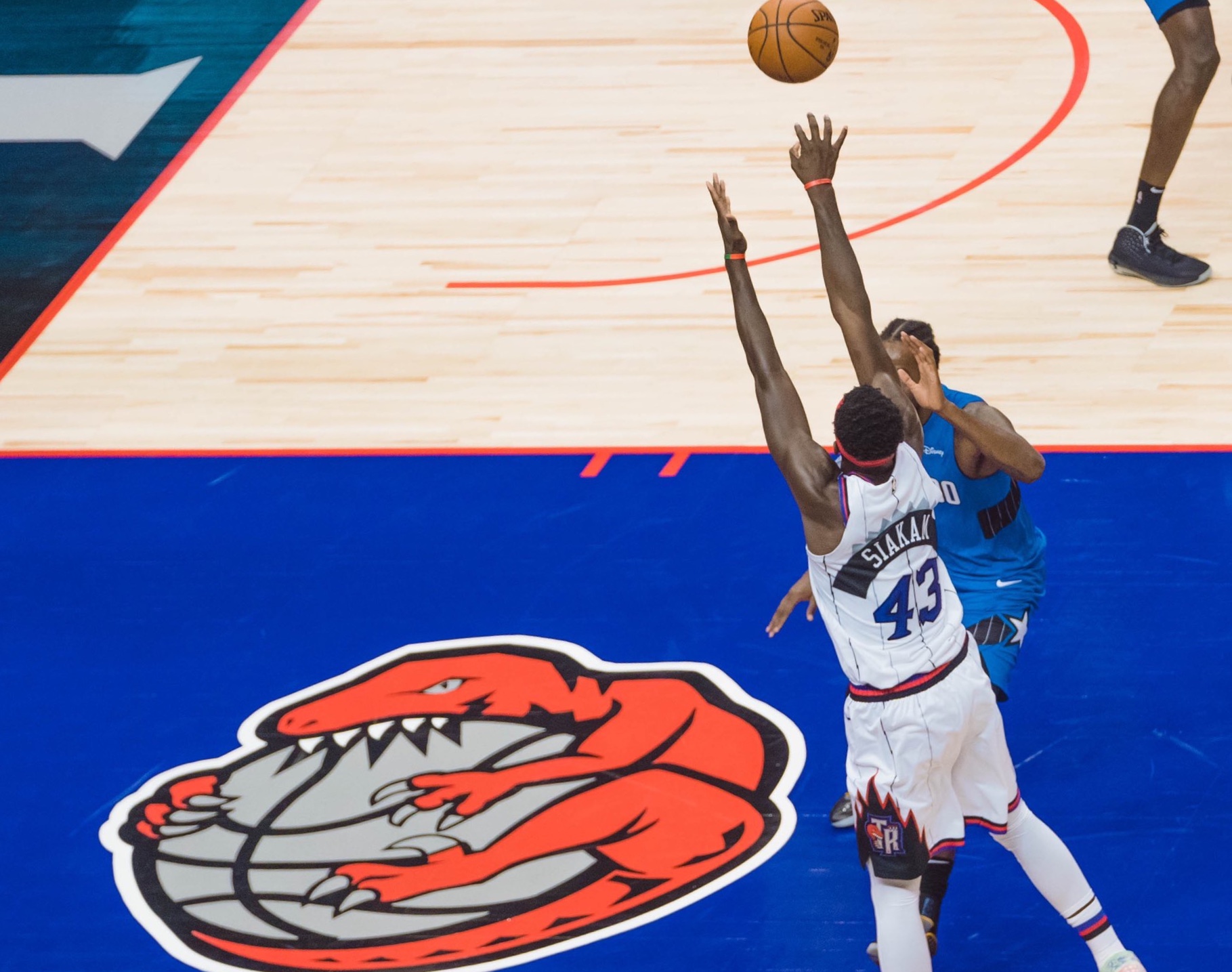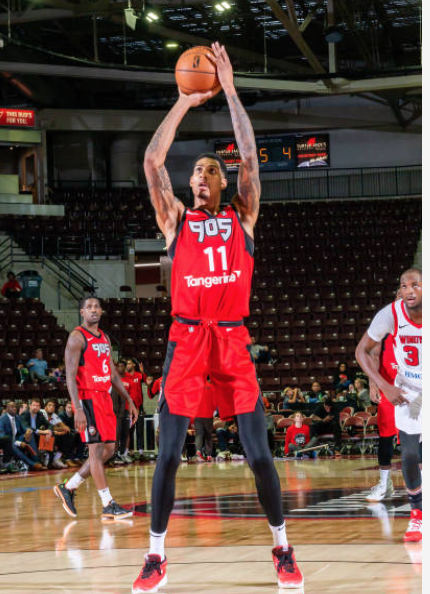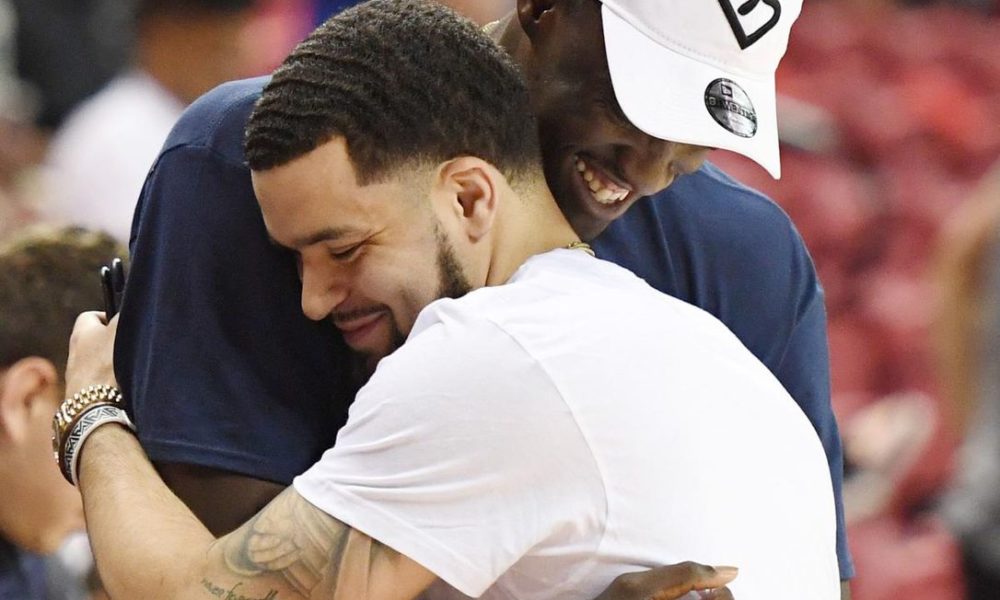What Pascal Siakam is accomplishing this year is virtually unprecedented. Set aside the numbers, the defense, the wins, and almost all the other fantastic elements of his 2019-20 season. No, those feats have been accomplished by other NBA players. But Siakam’s ability to improve his jump-shot has been modeled by perhaps only one or two players in modern NBA history, and even against them Siakam’s got an edge.
Let’s start with an overly complex chart, because that’s kind of my thing. Only 99 players have ever had one or more seasons of 450 3-point attempts in league history. Among that list, only a small handful were at one time non-shooters from deep, taking a negligible number of triples over a full season in which they played real minutes. Here’s the list of those players, focusing on the year they made a jump from non-shooter to shooter. There are others who could almost make the list, like Channing Frye or Clyde Drexler, although they never reached quite the level of volume shooter as the players on this list.

As a note, Blake Griffin, because he’s the best precedent for Siakam, has two years listed, just like Siakam himself. Both made their leaps in multiple stages, and we’ll be focusing on the two of them more specifically later, so they get two years. Siakam could easily have three listed, as he went from practically zero 3-pointers in his rookie year to over a hundred attempts in 2017-18. Including that year as well would overpower the chart, but suffice it to say that Siakam’s improvement has come in stages.
Kevin Love was already a shooter as a rookie, but instead of launching 3s, he took a huge whack of long 2s (21.2 percent of his shots). In his sophomore year, Love stepped behind the arc. Love’s jumper was billed as one of his greatest strengths heading into his draft. Love attempted over two 3s a game for UCLA, whereas Siakam attempted fewer than 0.5 for New Mexico State. (As a point of reference, Ariza and Payton were the only other players on the list to attempt one or more 3s per game in college.) The point is that Love was never a non-shooter to begin with.
To set Siakam apart, he is more accurate than any of the other players were in their leap years. Half of the players on the chart failed to record even one season at or above 39 percent from deep in their careers, and those who did reached that accuracy much later in their careers. Siakam hasn’t simply become league average on high volume, as the best non-shooters eventually became. He has become a more accurate shooter than the others, and it’s taken him less time.
Siakam’s shot profile is different from most of the others on the list. Players like Brook Lopez and Clifford Robinson made ridiculous one-year leaps in 3-point attempts, much like Siakam this year, but their shot characteristics look nothing like Siakam’s. Neither created any jumpers for themselves. Though pull-up data isn’t available for Robinson, only a tiny portion (less than five percent every year for which this information is available) of his triples were unassisted, whereas 40+ percent of Siakam’s triples this year are unassisted. The same argument, to a lesser extent, is true for Gary Payton, who was unassisted on fewer than 30 percent of his triples in 1996-97, the first year for which that data is available for him.
Siakam’s share of pull-up jumpers set him apart from all but Blake Griffin. However, Griffin’s jumper didn’t come out of nowhere, but took several years to develop.
Even as a rookie, 30.0 percent of Griffin’s field goal attempts came from within the 8-24 foot range of the court. That share increased steadily every year until in 2016-17, when he finally took a step back and started launching 3s. That an increasingly dedicated mid-range shooter became a 3-point shooter makes sense, even if his 3-point shooting evolved over two years of incredible jumps.
Siakam’s development was similar, if condensed. As a rookie, 30.7 percent of his attempts originated from the 8-24 foot range. The next year, the mid-range attempts plummeted to 8.8 percent as he launched 132 triples. Siakam did in two years what Griffin did in six. (It took Payton, who could also be included as having a similar arc, five years, and he never became even a league average shooter.)
“I think it is pretty quick,” said Nick Nurse when I asked him if Siakam’s timetable for improvement has been historic. “And you’ve heard me say this before, I still think he’s maybe 18 months away from being really deadly out there. Maybe I’m wrong, he seems to cut all my timelines in about half or, you know, more than that sometimes.”
And Siakam is shooting more and more accurately now than Griffin or Payton ever did in their careers.
In 2017-18, Siakam threw up a bunch of triples, but he only made 22.0 percent of them. The next year, he moved almost entirely to the corners, where his accuracy improved dramatically to 36.9 percent. Then a reliance on the corners was exposed as a weakness in the playoffs, so Siakam extended his range to the entire 3-point arc. Last year, he didn’t make a single jumper above the arc. Now, he’s regularly throwing in bombs like this.
Among players who’ve shot as many or more pull-up triples as Siakam this year, he’s 12th in the league in accuracy at 39.5 percent, ahead of more heralded pull-up shooters like Luka Doncic, James Harden, Kyrie Irving, and Trae Young. Siakam’s numbers aren’t those of just a passable shooter; he has evolved, in the span of a few years, from a complete non-entity to one of the best in the biz. Griffin has yet to reach that status. Gary Payton? Forget about it.
If Siakam keeps up his 3-point shooting pace and percentage to the year, he will stand alone atop the mountain of shooting development.
Siakam knew he needed to improve his shooting from above the arc after his playoff performance in 2018-19. Yes, the team won a championship, but there was work still to be done: “I have to be able to shoot the ball,” he said. “I have to be able to be dangerous not only going to the basket but on the perimeter, so that’s something I continue to work on every single day because when they put a big on me, I’ve got to be able to make shots so that they can come up a little bit and be able to take ’em off the dribble. So that’s on me.”
Siakam’s shot is the product of incredibly hard work.
“All summer long, he was always in the gym early in the morning, doing form shooting, doing all different types of shots,” said Raptors’ shooting specialist, Matt Thomas, of what he saw of Siakam’s shooting when he got to Toronto.
That work began long before this summer. Siakam’s been working on his shot for a long time. Assistant coach Jim Sann and Nick Nurse himself have been important development coaches in Siakam’s process.
“When it first started, was a lot of close-in stuff, a lot of form things including free throws,” said Nick Nurse. “I think it was like 450 [shots]. So it was like 150 form, 100 free throws, and 200 corner 3s was the bare minimum. And he started doing that every—I’m not overworking the guy—but it would take you an hour to get that in probably.”
“When he first started doing it, we gave him [that] daily workout, and about three days in he started doubling that, right, sort of doing it twice a day,” Nurse added.
When asked how Siakam improved more than any other player in league history, his teammates point to his work ethic first and foremost. You have to do the work and believe it will make a difference. Form is secondary. There’s a lot going on in Siakam’s jumper, but that’s not necessarily a bad thing. Siakam’s jumper is not as compact as most shooting specialists, but Thomas explains that as a result of Siakam’s long limbs. He must have movement in his jumper simply because he catches and dribbles the ball so far away from his release point. Regardless, Thomas pointed out that Siakam has excellent mechanics. His wrist motion, especially, is smooth and repeatable. Malcolm Miller explained that Siakam has more legs in his shot now than he ever before; his legs offer more strength and less extraneous movement than they did in years past. Siakam’s jump-shot may not look like Miller’s or Thomas’s, but it doesn’t matter what it looks like.
“[Form] is whatever you rep out,” explained Miller. “You build the reps, and you build the confidence in yourself.”
It’s possible that this is just a hot streak for Siakam to start the year. It’s possible that he cools off against gigantic defensive teams when games matter, as he did in shooting 2-of-14 in a back-to-back against both Los Angeles teams in mid-November. But opponents are no longer daring Siakam to shoot. If a team gives him space on the perimeter in the upcoming playoffs, that will be considered a win for Toronto.
When the Philadelphia 76ers came to Toronto towards the end of November, Siakam’s pull-up shooting was on the defensive game-plan. Remember, Philadelphia was the team, perhaps more than any other in Toronto’s playoff run, that dared Siakam to launch freely from above the arc, and he couldn’t hurt them. He shot 27.3 percent from deep in the series. Less than a year later, the Sixers were forced to completely change their defense to account for Siakam’s development. That series is why Siakam worked so hard on developing a pull-up jumper. And whatever Siakam wants to develop, he does.
Siakam has accomplished much in little time. He’s a champion. A Most Improved Player. An MVP candidate. And now, he’s a deadeye shooter taking the most difficult shots in the game: pull-up 3s. There is seemingly no limit to what Siakam can accomplish, and there’s already no precedent to his achievements. Perhaps it’s because Siakam didn’t start playing basketball until he was 17 years old, so there’s lots of untapped potential. Perhaps it’s because Siakam has some inherent physical advantage. Perhaps it’s because of Toronto’s unrivaled development program. It’s probably a combination of all three and more. Other teams may want to find their own Siakams in the draft, but it’s not so easy. He has an unrivaled work ethic and an unrivaled development arc, and Nick Nurse maintains that Siakam is just getting started.
There is only one Pascal Siakam, and it’s fortunate for the Raptors that he plays in Toronto.



